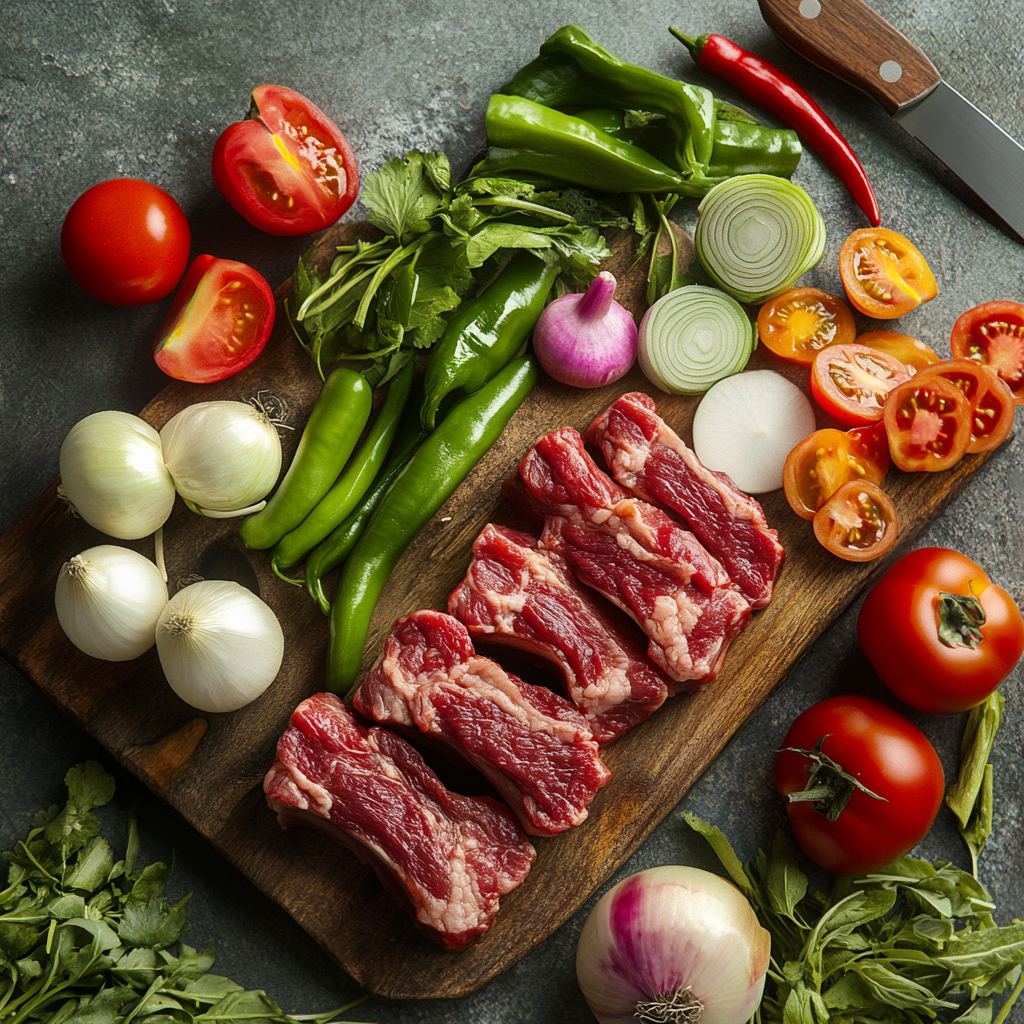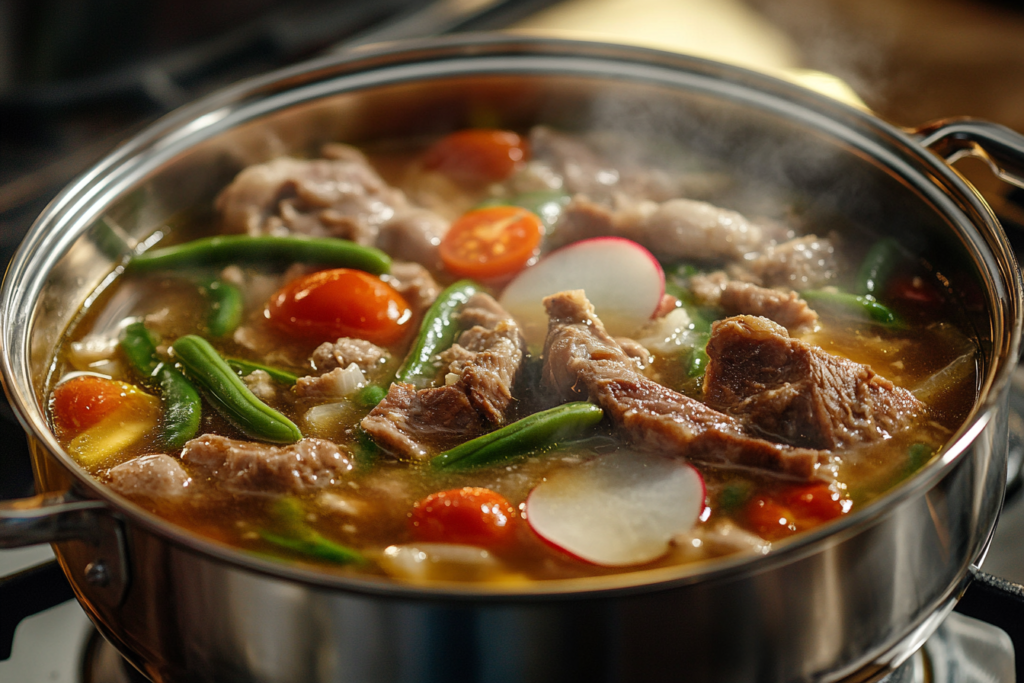1. Introduction
Sinigang is one of the most beloved dishes in Filipino cuisine, celebrated for its comforting flavors and tangy broth. Known as a sour soup, this traditional meal combines fresh vegetables, tender meat, or seafood with a signature sourness typically derived from tamarind. Whether you’re a seasoned cook or a beginner, learning how to brainly cook Sinigang opens the door to mastering a Filipino classic that is both delicious and culturally significant.
In this guide, we will walk you through the steps to prepare Sinigang, from selecting ingredients to perfecting the cooking process. With tips to avoid common mistakes and variations to suit dietary preferences, you’ll soon be able to create a dish that captures the essence of Filipino cuisine.
2. What is Sinigang?
2.1 How to Brainly Cook Sinigang: A Filipino Classic Explained
Sinigang is a traditional Filipino sour soup that brings together tender meat or seafood and a variety of vegetables in a tangy broth. The key to Sinigang’s flavor is the souring agent, with tamarind being the most common choice. However, other alternatives like calamansi, green mango, or bilimbi (kamias) can also be used.
This dish holds a special place in Filipino households, often prepared during family gatherings or served as comfort food on rainy days. Its versatility allows for multiple variations, with pork, shrimp, and fish Sinigang being the most popular.
2.2 Why Learning How to Brainly Cook Sinigang is Special
Sinigang is more than just a dish—it is a reflection of Filipino culture and values. Known for its bold and balanced flavors, it showcases the creativity and resourcefulness of Filipino cooking. The dish represents:
- Family and Togetherness: Sinigang is commonly shared during meals, fostering a sense of warmth and community.
- Simplicity and Versatility: Despite its complex flavors, the recipe is straightforward, and you can adjust it based on available ingredients.
Sinigang’s ability to blend fresh, local ingredients into a harmonious dish has made it a staple across the Philippines. Its sour broth, combined with vegetables like water spinach (kangkong), string beans, and radish, provides a well-rounded and nourishing meal.
2.3 Health Benefits When You Brainly Cook Sinigang at Home
Aside from its mouthwatering taste, Sinigang offers numerous health benefits. Its nutritious ingredients make it a wholesome dish for any occasion:
- Rich in Vitamins and Minerals: The vegetables in Sinigang—like spinach, string beans, and eggplant—are packed with essential nutrients, including vitamins A, C, and K.
- High in Protein: Whether you use pork, shrimp, or fish, Sinigang is a great source of protein, which helps build and repair body tissues.
- Boosts Immunity: Tamarind, the common souring agent, contains antioxidants and vitamin C, which help strengthen the immune system.
Combining flavor and nutrition, Sinigang is a balanced meal that is both satisfying and good for the body. Learn more about why Filipino Sinigang is considered healthy and how it contributes to a balanced diet.
3. Ingredients for Cooking Sinigang
3.1 Essential Ingredients You Need to Brainly Cook Sinigang

To brainly cook Sinigang, you need a combination of proteins, vegetables, and souring agents. Here is a list of the essential ingredients:
- Main Protein:
- Shrimp for Sinigang na Hipon.
- Fish (e.g., milkfish, tilapia) for Sinigang na Isda.
- Souring Agent:
- Fresh tamarind pods or tamarind paste (the most traditional choice).
- Tamarind soup mix (a convenient alternative).
- Other options: calamansi juice, green mango, or kamias (bilimbi).
- Vegetables:
- Tomatoes (for a rich and vibrant broth).
- Onions (to add depth of flavor).
- Radish (labanos).
- String beans (sitaw).
- Water spinach (kangkong).
- Eggplant (talong).
- Green chili peppers (optional, for a bit of heat).
- Seasonings:
- Fish sauce (patis) or salt (for added umami).
- Ground black pepper.
3.2 Optional Add-Ons to Enhance Your Sinigang Recipe
While the ingredients above form the base of Sinigang, you can add other components to elevate the dish:
- Root Crops: Add taro (gabi) for a thicker and creamier broth.
- Okra: This adds a unique texture to the dish.
- Miso Paste: Commonly added to Sinigang na Isda for a deeper, savory flavor.
- Seafood Mix: For a more complex flavor, combine shrimp, fish, and squid in one dish.
These optional ingredients allow you to experiment with flavors while still maintaining the essence of Sinigang. Explore more napa cabbage recipes to add variety to your dishes.
3.3 Choosing the Best Souring Agent to Perfect Your Brainly Sinigang
The souring agent is the heart of Sinigang, defining its tangy and refreshing flavor. Here’s how to choose the best one:
- Fresh Tamarind:
- Soak tamarind pods in warm water, mash the pulp, and strain the juice. This creates an authentic, natural sourness.
- Best for cooks looking for a traditional flavor.
- Tamarind Soup Mix:
- Convenient and widely available in Asian grocery stores. Simply mix it into the broth.
- Perfect for those who want to save time.
- Calamansi or Green Mango:
- Adds a slightly different sourness that is fruity and bright.
- Great substitutes when tamarind is unavailable.
Each souring agent gives the dish a unique twist, but all versions remain true to the comforting nature of Sinigang.
4. Step-by-Step Guide on How to Brainly Cook Sinigang
Mastering how to brainly cook Sinigang involves a few simple steps that bring out the dish’s tangy, savory flavors. Follow this guide to ensure a perfectly cooked Sinigang every time.
4.1 Preparing Ingredients to Brainly Cook the Perfect Sinigang
Before starting the cooking process, prepare all the necessary ingredients:
- Meat or Seafood: Clean and cut pork (e.g., ribs or belly) into bite-sized pieces. If using shrimp or fish, wash thoroughly and remove any impurities.
- Vegetables:
- Slice tomatoes and onions.
- Chop radish, eggplant, and string beans into uniform pieces.
- Wash leafy greens like kangkong and set them aside.
- Souring Agent: If using fresh tamarind, soak the pods in warm water, mash, and strain to extract the juice. For tamarind mix, measure the right amount for the recipe.
Proper preparation ensures a smooth and organized cooking process.
4.2 Cooking Process
4.2.1 Step 1: Sauté the Aromatics
In a large pot, heat a tablespoon of oil over medium heat. Add sliced onions and sauté until soft and translucent. Stir in chopped tomatoes and cook until the tomatoes break down and release their juices. This step builds the base flavor of the broth.
4.2.2 Step 2: Add the Protein
Add the pork to the pot and lightly sear until the meat changes color. If you’re cooking shrimp or fish, skip the searing step and add the seafood later in the process to avoid overcooking.
4.2.3 Step 3: Pour in Water or Broth
Pour in enough water or broth to fully submerge the meat. Increase the heat and bring it to a boil. Once boiling, lower the heat to a gentle simmer.
Pro Tip: Skim off any impurities or scum that rise to the top of the broth to keep it clear and clean.
4.2.4 Step 4: Simmer Until Tender

For Sinigang, let the meat simmer for 45–60 minutes or until tender. For seafood, reduce this time to 10–15 minutes.
- If you’re adding taro (gabi), add it at this stage and let it soften to thicken the broth.
4.2.5 Step 5: Add Vegetables
Add vegetables in stages, starting with those that take longer to cook:
- Radish and Eggplant: Add these first and cook for 5–7 minutes.
- String Beans: Add next and let simmer for another 3–4 minutes.
- Leafy Greens (Kangkong): Add these last and cook for 1–2 minutes or until just wilted.
This method ensures all the vegetables are perfectly cooked without becoming mushy.
4.2.6 Step 6: Incorporate the Souring Agent
Once the meat and vegetables are cooked, mix in your souring agent:
- If using tamarind mix, dissolve it in a small amount of water first, then add it to the pot.
- For fresh tamarind juice, pour it directly into the broth.
Taste the soup and adjust the sourness to your liking by adding more tamarind or water as needed. If you want a more detailed breakdown, check out this classic Sinigang recipe for additional tips.
4.2.7 Step 7: Season to Perfection
Season the broth with fish sauce or salt for added umami. Add a dash of ground black pepper to enhance the flavor. For those who enjoy a slight kick, toss in a couple of green chili peppers.
4.3 Final Touches and Serving

Once all the ingredients are cooked and the flavors have melded together, remove the pot from the heat. Serve Sinigang hot with steamed rice for a complete meal.
Serving Tip: Garnish with fresh green chili peppers or a splash of fish sauce for an extra burst of flavor.
5. Common Mistakes When Cooking Sinigang (And How to Avoid Them)
Even though Sinigang is a straightforward dish, a few common mistakes can affect its overall flavor and quality. Understanding and avoiding these pitfalls ensures your dish turns out perfect every time.
5.1 Overcooking Vegetables
One of the most common mistakes when learning how to brainly cook Sinigang is overcooking the vegetables. Overcooked vegetables lose their texture, becoming mushy and unappetizing.
How to Avoid It:
- Add vegetables in stages based on their cooking times. For example:
- Radish and eggplant go in first because they take longer to cook.
- String beans come next.
- Leafy greens like kangkong should be added last and cooked briefly to retain their vibrant color and freshness.
Cooking vegetables carefully preserves both their flavor and presentation.
5.2 Underwhelming Flavor
Sinigang is known for its distinct sourness, balanced with savory undertones. However, some cooks hesitate to add enough souring agent, resulting in a bland dish.
How to Avoid It:
- Use fresh tamarind whenever possible for a bold, authentic sourness.
- If using tamarind mix, taste the broth gradually as you add it to achieve the desired tanginess.
- Enhance the flavor with a dash of fish sauce and a small amount of salt to bring out the umami of the meat or seafood.
Adjusting the broth’s flavor to your preference is key to perfecting Sinigang.
5.3 Not Adjusting to Personal Preferences
Sinigang is a versatile dish, but failing to adjust it to personal or family preferences can make it less enjoyable. For instance, some people prefer a spicier version, while others enjoy a thicker, richer broth.
How to Avoid It:
- Experiment with additional ingredients: Add green chilies for a spicy kick or taro (gabi) to thicken the broth.
- Adjust the sourness to match your taste by increasing or reducing the amount of tamarind or other souring agents.
- Try protein alternatives like shrimp or fish to suit dietary preferences.
By customizing Sinigang, you can make it a dish that everyone will enjoy.
6. Variations of Sinigang
One of the best things about Sinigang is its versatility. While pork Sinigang is the most well-known version, there are several variations of this beloved Filipino dish. Each type highlights unique flavors and ingredients, offering something for everyone. Let’s explore the most popular variations of Sinigang.
6.1 Shrimp Sinigang (Sinigang na Hipon)
Sinigang na Hipon is a lighter variation that uses fresh shrimp as the main protein. This version offers a seafood twist while maintaining the dish’s signature sourness.
Why it’s Special:
- Shrimp adds a subtle sweetness that complements the tangy broth.
- This version cooks quickly, making it perfect for busy days.
Key Tips:
- Add the shrimp towards the end of the cooking process to avoid overcooking.
- Enhance the seafood flavor by adding a small amount of fish sauce and green chilies.
6.2 Fish Sinigang (Sinigang na Isda)
Sinigang na Isda features fish, such as milkfish (bangus), tilapia, or salmon, simmered in a sour broth with vegetables.
Why it’s Unique:
- The delicate flavor of fish pairs beautifully with the sour and savory broth.
- It’s a healthier alternative, providing a lean protein option.
Key Tips:
- Use fresh fish and handle it gently to avoid breaking it apart in the soup.
- Add miso paste to create a savory depth of flavor, a popular twist known as Sinigang sa Miso.
6.3 Beef Sinigang (Sinigang na Baka)
This variation uses beef cuts, such as shank or short ribs, simmered until tender. The result is a richer, heartier version of Sinigang.
Why it’s Comforting:
- The beef broth delivers a more robust and savory base compared to pork or seafood.
- It’s perfect for colder days when a hearty soup is needed.
Key Tips:
- Use beef shank or short ribs for a deeper, more flavorful broth.
- Simmer the beef for a longer period to achieve fall-off-the-bone tenderness.
6.4 Vegetarian or Vegan Sinigang
For those who prefer plant-based meals, Sinigang can easily be made vegetarian or vegan without compromising flavor.
What to Use Instead of Meat:
- Tofu, mushrooms, or tempeh can replace pork, shrimp, or fish.
- A variety of fresh vegetables—like string beans, radish, kangkong, and okra—provide texture and nutrition.
Key Tips:
- Use tamarind or other natural souring agents for a clean, plant-based broth.
- Add miso paste or vegetable broth to enhance the umami flavor.
7. FAQs About How to Brainly Cook Sinigang
7.1 What’s the Best Meat for Sinigang?
The most popular choice is pork, specifically pork ribs or belly, as it adds a rich and savory flavor to the sour broth. However, other options include shrimp (Sinigang na Hipon), fish (Sinigang na Isda), or beef (Sinigang na Baka).
7.2 How Do I Achieve the Right Sourness?
The perfect sourness depends on the souring agent:
- Use fresh tamarind for a bold, authentic flavor.
- Tamarind soup mix is convenient and consistent.
- Alternatives like calamansi, green mango, or kamias can provide a fruity tang. Adjust gradually and taste the broth as you go.
7.3 Can I Cook Sinigang Without Tamarind?
Yes! While tamarind is traditional, you can use calamansi juice, green mango, or even lemon juice as alternatives. These ingredients still deliver the dish’s signature sourness.
7.4 How Long Does It Take to Cook Sinigang?
Cooking time depends on the protein:
- Shrimp: 10–15 minutes.
- Fish: 15–20 minutes.
Vegetables should be added in stages to avoid overcooking.
7.5 What’s the Best Way to Store Leftover Sinigang?
Store leftover Sinigang in an airtight container and refrigerate for up to 2–3 days. Reheat gently over low heat to avoid overcooking the vegetables or meat. Avoid freezing, as the vegetables may lose their texture.
8. Conclusion
Learning how to brainly cook Sinigang gives you the tools to master a dish that is both delicious and culturally significant. This Filipino classic is more than just food; it’s a symbol of warmth, comfort, and family. By following this guide—from choosing the best ingredients to perfecting the sour broth—you can recreate Sinigang in all its flavorful glory.
Whether you prefer pork, shrimp, fish, or a vegan twist, Sinigang offers endless possibilities to customize and enjoy. Its balance of sour, savory, and hearty notes ensures it remains a crowd favorite at any table.
So, gather your ingredients, prepare your pot, and bring the rich, tangy flavors of Sinigang to life. Happy cooking!
